SPI has produced some spectacularly seamless visual effects for the period drama of Valkyrie from director Bryan Singer (Usual Suspects, Superman Returns) and staring a serious dramatic performance from Tom Cruise (War of the Worlds. Rich Hoover, vfx supervisor on Valkyrie spoke to us about the complexity of doing such a powerful historical film.
In a country in the grips of evil, in a police state where every move is being watched, in a world where justice and honor have been subverted, a group of men hidden inside the highest reaches of power decide to take action. Tom Cruise stars in the suspense film, based on the true story of Colonel Claus von Stauffenberg and the ingenious plot to eliminate one of the most evil tyrants the world has ever known. Director Bryan Singer re-teams with Academy Award-winning Usual Suspects screenwriter, Christopher McQuarrie, to bring to life the story of the men who led the operation to assassinate Hitler. The film also stars an acclaimed cast including Kenneth Branagh, Bill Nighy, Tom Wilkinson, Eddie Izzard, and Terence Stamp.
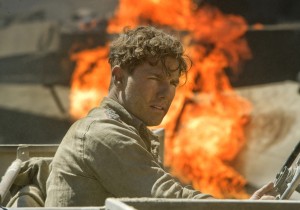
A proud military man, Colonel Claus von Stauffenberg is a loyal officer who serves his country all the while hoping that someone will find a way to stop Hitler before Europe and Germany are destroyed. Realizing that time is running out, he decides that he must take action himself and joins the German Resistance. Armed with a cunning strategy to use Hitler’s own emergency plan – known as Operation Valkyrie – these men plot to assassinate the dictator and overthrow his Nazi government from the inside. Operation Valkyrie was designed for the possible loss of communication from the Hitler Bunker, but as we know the Stauffenberg plot failed surprisingly, given that one bomb was successfully deployed.
Combining historical accuracy with the recreation of vivid and gruesome personal injuries, whilst bringing realism and sensitivity to the subject matter, is a challenge well met in Bryan Singer’s Valkyrie. Many scenes, in particular the initially more complex opening North African attack, were prevized by the Third Floor. The Third Floor in LA, which has collaborated with Singer on several occasions, and believes that the outstanding results achieved come about from extensive research and attention to detail, ensuring that the final result is as authentic and realistic as possible.
The film was shot in Germany at various locations where many of the actual events occurred, including the historic Bendlerblock, a memorial for the July 20 plot against Hitler. Recreating the atmosphere of urgency and paranoia that existed within the German Resistance fell to Rich Hoover and the team at Sony Pictures Imageworks.
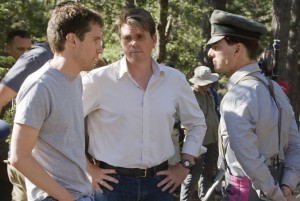
fxguide: Valkyrie is a really interesting film, because in many respects, and I believe Bryan Singer himself said this, there are two ways that you could have looked at a film like this – as a cross between Usual Suspects and Born on the Fourth of July, or Mission Impossible crossed with Superman Returns. So it could be viewed as a big budget, megastar production, or a more thoughtful, smaller film. Where do you think the film ended up?
Rich Hoover: I’d see it more as a thoughtful, independent film, but it obviously has big stars in it and very big personal value. I term the Superman/Mission Impossible connotation to be more of an action-based story rather than an almost documentary-based story.
fxguide: It is a true story, and that adds a tremendous amount of weight to your role as visual effects supervisor, because there’s a need for enourmous sensitivity, in a period where there’s actual film archives of it, so we know what it looked like.
Rich Hoover: Absolutely, that’s what made the film fun for me. It was almost like going back to college. You’re reading about the history of the characters, and there are a lot of historical photographs of both the characters and the places where events took place. The filmmakers went to an extraordinary amount of effort to shoot the story, either in the actual locations where the original events took place, or places almost identical to them. That made it much more real life for everybody working on the film. You contemplate that mentally when you’re there – wow, they were actually there, they were shooting people right here – and it made it really fun to think about and to be involved in.
fxguide: In terms of visual effects, you’re not primarily trying to produce a documentary, you’re trying to produce a dramatic film, and yet people are very aware of the ‘accuracy’ nature of it. So from the bombing raids of Northern Africa, for example, was there a part that worked dramatically, but wasn’t how it may actually have been?
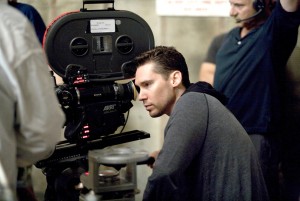
Rich Hoover: I think both of those considerations came into play. Bryan and, of course, Chris McQuarrie the writer, were both very concerned with producing a historically accurate film, and so we started with the whole market research; from where did these events occur, and what did everything look like, to what kind of photographic history can we find, and so on. Chris and Bryan did a lot of interviews with people of the era that knew Stauffenberg and knew of the actual events to acquire as much information as they could about what really happened, and about what people’s needs or attitudes were, and this kind of thing.
As a vfx supervisor, I did a lot of homework about what the environments looked like in 1943 when this took place, and what Stauffenberg’s injuries, or at least how people with similar injuries looked, what kinds of surgical procedures were used, both within the field and in the hospital – what did the scars look like, how did they heal – all those kind of things. There was an amazing amount of research done to try to make it as authentic and real as possible.
Having said that, Bryan and I would discuss, scene by scene almost, what was appropriate for the audience to see, always keeping an eye on making the story be the most important thing, rather than, say, Stauffenberg’s injuries that were just part of his character. From the beginning we talked about how Tom Cruise would behave and use his injuries – the loss of his hand, or his missing fingers. There were several accounts that Stauffenberg was not self-conscious about his injuries, he accepted them fully and behaved very normally about them, and expected everyone around him to accept that that was what he looked like, and that was part of him. He wasn’t hiding it.
fxguide: So just to set that up for someone reading this, Stauffenberg was in North Africa in the 10th Panzer Division, and in April 1943 there was the incident that caused him to lose his eye, his right hand, and the fourth and fifth fingers on his left hand, is that correct?
Rich Hoover: Yes, that’s right. He was wounded in North Africa when his column was attacked by British Spitfires.
fxguide: That does totally play into the plot of the assassination attempt, because Stauffenberg had to have a certain amount of dexterity to work with the pencil detonator, and the bomb. Going in, you must have known that the amputee nature of some of his injuries would figure prominently. What was the strategy for dealing with that, purely from a technical level?
Rich Hoover: Well, I think Bryan really looked at what needed to be happening and knew that there were some documented facts about the explosives themselves, and the tools and the special pliers that were made that he could hold in his hands. So whilst there was no eye witness left alive to say that’s what they did, I thought his interpretation was very plausible in how he may managed this. The fact that he used his attaché to help him manage with the weaponry and tools, and getting it armed and built in an appropriate manner, I think seems very reasonable. They did find the bomb with them that they did use; they did find the pliers; the Germans are so accurate in their documentation, there’s a full report from where they scoured the road from the Wolf’s Lair to the airstrip and found these things, so I think there was quite a lot of facts that went into what you see in the film, and the interpretation of how he got the weapons ready.
fxguide: Because he had two bombs but he only had time to arm one, and the other was discarded when he left the bunker.
Rich Hoover: Correct. We know that he had two bombs with him; we know that only one of them was used. We really don’t know what happened that didn’t allow him to arm both.
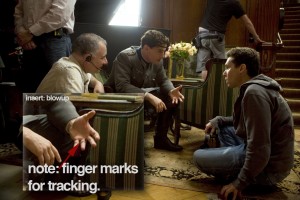
fxguide: From a vfx point of view, how did you produce Tom Cruise without hands and fingers?
Rich Hoover: We photographed and measured Tom’s hands very carefully. He had a cast made of it for the prosthetics, both of the stump of his right hand, and prosthetic approaches of how to show his missing digits on his left hand. We found that the prosthetics made his fingers look a little fat, and there weren’t any photographic references of those types of injuries that supported any swelling or change in dimension of digits. I ended up trying some greenscreen sleeves on the fingers, and different ways of outlining where the fingers would be missing, but this had about as many negative properties – for example, the greenscreen sleeves would cast green spill all over the other parts of the hand that we wanted to keep, and I didn’t want to just replace the hand, I wanted to keep as much of the real photographed hand as possible.
I ended up working with Tom’s make-up artist, Sarah, and coming up with make-up that was the same colour as his skin when in shadow; I had her paint lines in each finger pretty much every day, to a point that we agreed upon on a certain crease in his skin that would allow the artist later in post-production to see exactly where the finger should be removed in a very consistent manner. The fact that it was a shadow colour meant that we could use that shadowing of the skin colour as part of our process if we wanted.
fxguide: So then was it just a digital digit removal?
Rich Hoover: We made a copy of his hand using his measurements and photographs, and the scan from the cast of the mould of his hand, and we photographed and then rewound those together and modified it until it fit perfectly. We then tracked, frame by frame, everything he did, on every shot, in 3D, and modelled and lit the fingers to match the lighting and the skin quality on every shot, and then very painstakingly used as little of the digital hand as we could to make that illusion successful.
Most of it had to do with rebuilding the palm, because most of the time Tom would bend those two fingers down toward his palm, and that’s also what made it look the most natural, like if you had to pick up a phone. We would talk about it and say, ‘well, how would you do this if you didn’t have those digits?’ You can’t just do anything if you don’t use them. You can’t touch fabric, you can’t move things on a table, and he’s not building the bomb with those digits because they’re not really there, that kind of thing.
So I would watch it being shot, and Tom was really terrific at doing it, within a few days of shooting, he held himself very naturally. In fact there was one scene in the very beginning in Africa where he’s writing in his notebook about his thoughts about the war and Hitler and the travesties that are going on, and he’s writing with his left hand – and he’s not left handed – and writing in German. So he’s extremely athletic and dexterous with his ability.
fxguide: Away from the actual work with Tom Cruise, there were obviously a lot of other aspects that go along with the making of any historical drama that need to be taken into account. Starting with the North Africa account, I believe there was heavy previz done by Third Floor.
Rich Hoover: Yeah, we did a lot of previz at the very beginning of the film. The sequence was much larger than it is in the film now, than when we started. I couldn’t be totally accurate, but there’s some fairly sketchy information about exactly where it occurred. They know it was in North Africa, they know it was the Panzer Division, but I guess there were varying accounts as to where exactly they were when this happened, other than they were on some sort of road when they were attacked by an air strike. We did our best to recreate that situation. It had more to do with a little filling in of the back story about how Stauffenberg got to North Africa.
Anyone who is a historian, or who is interested in this kind of history, would probably do themselves a favour to read further about Stauffenberg’s life, and what led him to making this decision to try and preserve Germany and their place in the world, which was what they were trying to do before the Allies invaded and millions of Europeans got killed. It was a noble cause, it really was, and that’s what makes it a great story. But there was a lot of previz and forethought into how to plan out that scene – because that scene is as much about showing him injured as it is about telling the audience his point of view of the war, and how the German military’s being run, and how decisions are being made, and where it’s taking Germany.
fxguide: And to just pull that off visually, were there any actual aircraft?
Rich Hoover: Absolutely. There are real P40s in that scene, and real German tanks and vehicles; great uniforms – as much as could be done. Even in the German airfield scene, the Russian flying fields by the Wolf’s Lair, we had real Junkers and Messerschmidts. We augmented them here and there – in some places we cut out the real planes, did real moves on them or retracked them to show more planes. We added CG planes, but the CG was only added as a last resort. The intended design was to shoot as much footage of real planes as possible.
fxguide: In the rest of the film, there must have been a reasonable amount to do with the set extensions, or to remove modern day life, to bring those actual historical locations into the correct period.
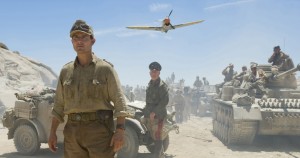
Rich Hoover: Absolutely, we did all of the above using a variety of techniques. Some were just 2D map extensions, some were 2½ D extensions, some were just paint-out of modern day things. In the case of the Wolf’s Lair, we digitally built Hitler’s retreat, based again on historic photographs, and the textures and materials that they used then. Hitler’s retreat went through quite a metamorphosis from the time he bought it until 1943, and even beyond that, it kept changing and growing. There were quite a few photographs of it, of him with different officers, or his longtime companion and so on, and that allowed us to build something that I think is very accurate to the time.
In Germany, a lot of these buildings still exist that were part of the German infrastructure during the war, as well as key architectural buildings of the time. The airport is there, and the Lufthansa building that we used as one of the headquarter buildings. The German city government, with traffic poles and light poles, and so on, were very cooperative in having all of those taken down and removed for brief periods of time, so that pretty much all we had to do was paint out things that were permanently bolted down that they couldn’t remove.
fxguide: That’s an extraordinary level of cooperation.
Rich Hoover: Yeah, and on either side of these key buildings, we had acquired historical photographs of those original streets and buildings. We did try to follow as closely as possible to what was actually there – there was some dramatic license, but for the most part it was the right architecture, the right layout etc., that was really there at that time. Hopefully, when people watch the movie they will have no idea what was real and what wasn’t. They’ll just watch and enjoy the story.
fxguide: It is a gripping story, and it is easy to paint all German soldiers of that time as being Gestapo or SS, whereas in fact, the Colonel wasn’t even a member of the Nazi party.
Rich Hoover: You know, I think that’s one of the most interesting things that I learned being involved with the film, even myself being a kind of war film buff – I love to watch World War II films. There have been a lot of films that I enjoy, and the basic notion that all German soldiers are Nazis, that kind of generalised look at military soldiers in Germany, that’s not true at all. There was this political party of the German soldiers, the Nazis, and then there was the German Military, and they weren’t always on the same page. To some degree, that’s what the movie is about.
fxguide: In terms of pipeline, was this a fairly traditional pipeline that you would have used on any of your earlier films?
Rich Hoover: Absolutely. This was a film about reusing existing technology and methods that we had used in other films. Our skin shader, for example, was something that we built through Beowulf, Spiderman and Superman. We did hire Robert Stromberg to do one matte painting of a church for a scene in which Bill Nighy’s character is talking to Tom Cruise’s character, trying to convince him to join this group and carry out this mission. It’s based in a church that’s still a monument in the middle of Germany.
In the film, the roof was blown off in a bombing raid but the walls of the church still existed. We had photographic reference of people having a candlelight service in the church with the roof removed, and that’s where this idea came from. Although we shot it in a church in Pasadena, we removed the roof digitally, and did a matte painting, and that was based on the real German church. We were using the best technique for this kind of movie in making it as seamless and invisible as possible.
In the end SPI once again produced a great visual effects that served a powerful film in the best possible way.
